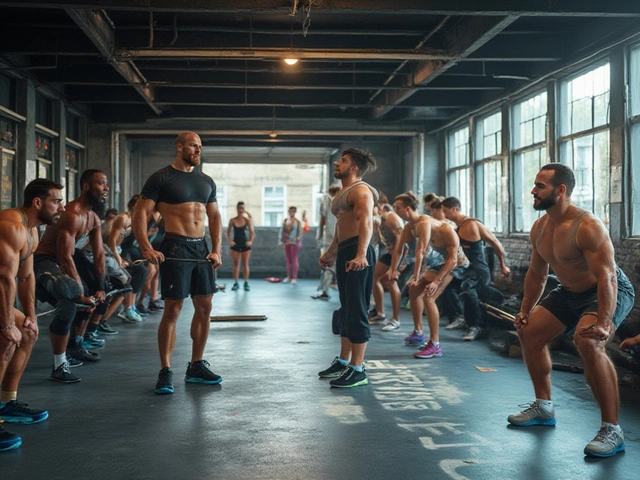Progressive Overload Calculator
Determine how much weight to add to your lifts based on the article's progressive overload principles. Follow the 2-consecutive-workout rule: increase weight when you complete the top rep for two sessions.
Looking for a roadmap that actually works at the gym? A Gym workout plan is a structured schedule that blends strength, cardio, and recovery so you can keep getting stronger without crashing.
Key Takeaways
- Mix strength, cardio, and mobility each week.
- Use periodization and progressive overload to keep progressing.
- Recovery (sleep, nutrition, mobility) is just as important as lifting.
- Start with a 3‑day split and add days as you feel comfortable.
- Track lifts, reps, and how you feel to fine‑tune the plan.
Understanding a Good Gym Plan
A solid gym workout plan isn’t a one‑size‑fits‑all template. It respects three core ideas: what you want to achieve, how your body adapts, and how you recover.
First, define your goal. Want to lift heavier? Prioritise Strength training. Want to lose a few kilos? Add more Cardio. Most people need both, plus a dash of mobility work.
Second, remember that muscles need a stimulus and then a break. That’s where Periodization and Progressive overload come in.
Third, recovery - sleep, nutrition, and active recovery - decides whether you’ll get stronger or just stay sore.
Core Pillars of a Balanced Plan
Below are the five pillars you’ll see in any effective gym routine.
1. Strength training
This is the backbone for building muscle and bone density. Focus on compound lifts like squats, deadlifts, bench press, and rows. Aim for 3-5 sets of 5-8 reps for strength, or 8-12 reps for hypertrophy.
2. Cardio
Cardio burns calories, improves heart health, and speeds recovery. Mix steady‑state sessions (30‑45 minutes at moderate intensity) with high‑intensity interval training (HIIT) for efficiency.
3. Mobility work
Dynamic warm‑ups and post‑workout stretching keep joints supple and prevent injuries. Spend 5‑10 minutes on hip openers, shoulder circles, and ankle dorsiflexion drills.
4. Recovery
Recovery includes sleep (7‑9 hours), foam‑rolling, and active rest days. Without it, progressive overload turns into over‑training.
5. Nutrition basics
Fuel your body with enough protein (1.6‑2.2g per kg body weight), carbohydrates for energy, and healthy fats. A simple rule: eat a balanced meal within two hours after training.

How to Build Your Weekly Schedule
Start with a three‑day split. Here’s a sample that hits each pillar without over‑loading any single muscle group.
| Day | Focus | Key Exercises (Sets × Reps) |
|---|---|---|
| Monday | Upper‑body Strength + Light Cardio | Bench Press 4×6, Bent‑over Row 4×6, Overhead Press 3×8, Pull‑ups 3×max, 20min moderate‑pace treadmill |
| Wednesday | Lower‑body Strength + Mobility | Squat 4×6, Deadlift 3×5, Lunges 3×10 each leg, Hip‑flexor stretch 3×30s, 10min foam‑roll |
| Friday | Full‑body Conditioning + HIIT | Kettlebell Swings 3×15, Push‑press 3×8, Plank 3×60s, HIIT: 30s sprint / 90s walk×8 (total 20min) |
Adjust the volume (sets/reps) based on your experience. Beginners may start with 2 sets per exercise; seasoned lifters can up to 5 sets.
Progression Strategies
Simply repeating the same numbers won’t get you anywhere. Use these proven methods.
Periodization
Divide your training into 4‑week blocks: three weeks of steady progression followed by a deload (reduce volume by 40‑50%). This mirrors the natural ebb‑and‑flow of recovery.
Progressive Overload
Each week, aim to add a small amount of stress - more weight (2‑5lb), an extra rep, or a few extra minutes of cardio. Track it in a notebook or app.
Auto‑regulation
Listen to your body. If you’re unusually sore, swap a heavy day for a lighter technique session. The goal is consistent forward motion, not forced intensity.
Recovery and Nutrition
Without proper recovery, you’ll plateau or injure yourself.
Sleep
Aim for 7‑9hours of uninterrupted sleep. Growth hormone peaks during deep sleep, helping muscle repair.
Protein Timing
Consume ~25‑30g of high‑quality protein within 30‑60minutes post‑workout. Greek yogurt, whey shake, or a lean chicken breast work well.
Carbohydrate Re‑fuel
Carbs replenish glycogen stores used during cardio and heavy lifts. A banana or a small bowl of oatmeal is quick and effective.
Active Recovery
On rest days, keep moving with light activities like walking, cycling, or a yoga session. It boosts blood flow and speeds waste removal.

Common Mistakes to Avoid
- Skipping warm‑ups. Jumping straight into heavy lifts spikes injury risk.
- Doing too many cardio sessions and neglecting strength. You’ll lose muscle instead of gaining power.
- Ignoring progressive overload. Without added stimulus, the body won’t adapt.
- Neglecting nutrition. Even the best plan stalls without proper fuel.
- Training to failure every set. It exhausts the nervous system and hinders recovery.
Quick Checklist Before You Finish
- Set a clear primary goal (strength, fat loss, endurance).
- Pick a split that matches your schedule (3‑day, 4‑day, full‑body).
- Include at least one compound lift per major muscle group.
- Plan cardio and mobility on non‑lifting days or after lifts.
- Schedule a deload week every 4‑6 weeks.
- Track sleep, protein intake, and weekly lift totals.
Frequently Asked Questions
How many days a week should a beginner train?
Three full‑body sessions spread over the week (e.g., Monday, Wednesday, Friday) give enough stimulus while allowing adequate recovery.
What’s the ideal rep range for building strength?
Aim for 4‑6 reps per set with heavy weights (≈85‑90% of your 1‑RM). Keep sets to 3‑5 for each lift.
Can I do cardio on the same day as strength training?
Yes-just schedule cardio after lifts, or keep it low‑intensity. High‑intensity cardio before heavy lifts can reduce strength output.
How important is protein for a gym plan?
Protein is crucial; it provides the building blocks for muscle repair. Aim for 1.6‑2.2g per kilogram of body weight per day.
When should I increase the weight on my lifts?
If you can comfortably complete the top rep of all sets for two consecutive workouts, add 2‑5lb (or 1‑2kg) to the bar.







